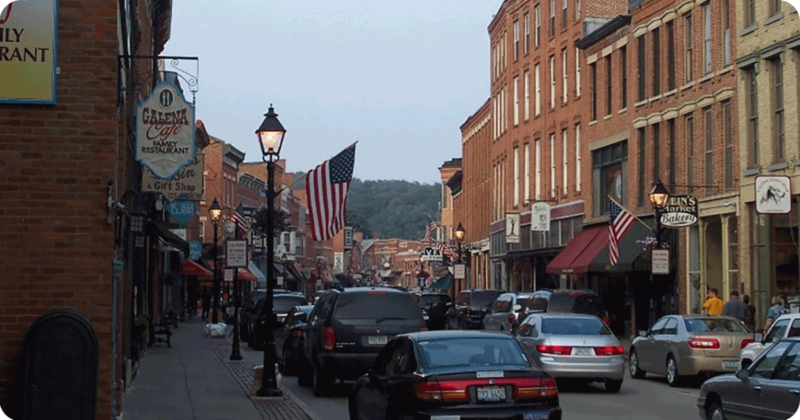
Galena, Illinois, is seen as a successful downtown district, even though parking can be limited. A vibrant district is a draw, and ample parking alone does not attract visitors. Thoughtful signage and management, rather than the development of parking lots, is often a more effective approach to revitalization.
Based on how often parking is mentioned as a top challenge in community surveys, you’d think that visitors to downtowns spend hours circling, looking for spaces. While some select districts have legitimate parking shortages, most issues stem from problems with parking awareness and/or management. Parking is often the first experience a downtown visitor has, and whether this experience is positive or negative may color their overall perception of the district. Making the district as easy to navigate as possible with adequate wayfinding, visible signage, and marked lots helps make a positive first impression. For day-to-day audiences or those with more specific challenges, pricing and management strategies can ensure a parking system that operates efficiently and can accommodate all types of downtown users, supporting a thriving downtown economy—both day and night.
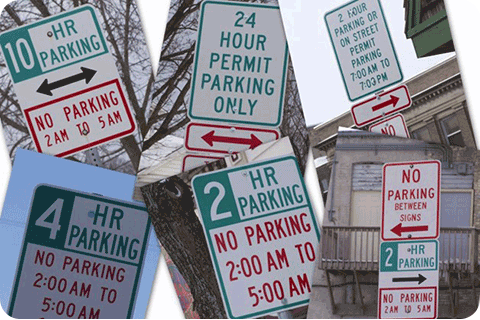
Confusing, contradictory, and deficient signage is a deterrent to visitors hoping to spend time in your district.
Perception and awareness
While parking is a common complaint, it’s rarely the main deterrent to individuals wanting to visit downtown. In the many studies conducted by Wisconsin Main Street over the years, people over age 65 were the only demographic who identified parking challenges as a primary reason for not visiting a district. In this case, the challenge lies not in finding parking, but rather, in the need to then walk some distance to their destination, potentially navigating snow, ice, stairs, or other hazards. Providing short-term spaces near convenience destinations and ample and accessible seating throughout the district helps accommodate these users, and, if well-located and attractive, has the added benefit of encouraging people of all ages to linger downtown. Additional measures, such as conducting a walk audit or adding ramps and handrails at key locations, can also make downtown easier to navigate for everyone.
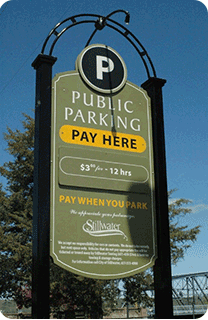
For other visitor groups, parking may be an annoyance. Lack of clear signage or rules may foster uncertainty, especially for tourists or those who visit infrequently. Providing clear instructions can help newcomers feel the same sense of confidence in locating parking that regular visitors experience. Effective strategies include creating readily identifiable lots with directional signage, entrance signage, and clear parking guidelines. In today’s digital age, providing lots with names and addresses that can be entered into GPS mapping programs allows visitors to navigate directly to the closest suitable lot, eliminating the frustration associated with locating one upon arrival.
Image at left: Visible and clear signage makes it obvious to visitors where they should park, making a visit to your district more pleasant.
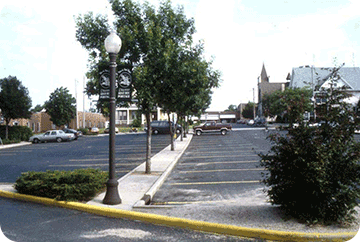
Quality design can further enhance the parking experience. Adding landscaping, shade, human-scaled lighting, and simple payment systems, where required, makes visitors confident to leave their car and explore the district on foot. In contrast, visitors parking on the street or in less welcoming spaces may choose to move their cars more frequently or curtail their visits rather than risk receiving a parking ticket.
Image at right: Well-designed parking lots with adequate lighting and landscaping are more welcoming and feel safer, encouraging employees and visitors to choose long-term lots over on-street parking spaces needed for quick stops.
Parking management
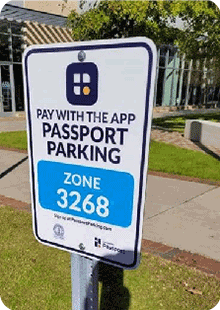
Mobile and interactive payment systems make it easy for visitors to pay for parking without carrying coins, needing to return to their vehicle, or standing in line at kiosks.
Scarcity of parking in a given area can often result from users parking in areas that are best suited for other groups. Examples include building residents parking in the front row of a surface lot or business owners or employees parking on the street in front of their (or their neighbors’) businesses. Having long-term users occupy spaces that are appropriate for short-term visitors can cause several negative outcomes: impacting local business, producing unsafe loading practices, and even creating challenges in retaining businesses or upper-floor residents. Many downtown businesses, such as coffee shops, rely on customers being able to use nearby on-street parking spaces for quick errands. Others, like pharmacies, have a customer base that is older or has limited mobility and therefore needs nearby spaces to access necessary services safely. It is important to help downtown stakeholders understand why on-street spaces have time restrictions, the potential impact on their business or the health of downtown from a lack of customer parking, and the location of spaces that more effectively meet their needs elsewhere in the district.
Surveying user groups downtown can help identify constraints to address with a change in policy, outreach, design, or pricing. Common examples of challenges readily addressed in this way include:
- Few or no spaces available for long-term parking (eight hours or more) to accommodate daytime employees
- Poor lighting along sidewalks or in parking lots, causing employees to feel unsafe walking to their car alone after dark
- Lack of spaces/accommodations for overnight parking for residential guests or visitors wishing to stay overnight after evening activities
- A mismatch between on-street meters, surface lot permits, and ticket prices that creates incentives for users to choose alternatives other than the most appropriate parking location
In each of these examples, there are simple fixes that can be made to accommodate the very reasonable needs of these important user groups. Once any changes are implemented, it is important to launch a targeted outreach and marketing campaign to help educate specific users about the changes and provide them with information on the location, cost, and process associated with securing parking in preferred locations. As with any big change, there may be a need to review and adjustment during the transition period, so an enforcement grace period is appropriate.
Parking enforcement
In the absence of effective parking management, none of the above strategies will be effective. While the goal of parking management should never be to make money by issuing parking tickets, strategic enforcement is required to ensure good behavior by downtown constituents so that the overall needs of the community are met. Public parking, both on the street and in parking lots, is a public good and needs to be allocated in ways that will help downtown grow and thrive, rather than allowing individual users or groups of users to monopolize it. Because most user groups will react strongly to being ticketed for the same practices they’ve been following for years, it is important to complete a parking inventory and survey to identify times and locations that need enforcement most. Communicating with downtown audiences about improvements made to the parking system, any planned changes in enforcement, and the reasons behind these changes is imperative. This will head off concerns and frame the narrative as a positive change for constituents, though it may initially feel like an inconvenience. In many communities, complaint-driven parking enforcement which targets enforcement to areas or periods of frequent abuse or community concern rather than regular patrols can be highly effective, as downtown stakeholders can readily distinguish between a car parked in the same (inappropriate) location daily versus a one-time visitor who might be in town for a meeting, allowing for more targeted enforcement.
For larger cities or communities with significant seasonal changes in parking needs, implementing a digital parking payment system allows for dynamic pricing—that is, charging different rates for prime parking spaces during peak times. This provides an economic incentive for employees or residents to find alternative parking locations during periods of high demand. Multiple Wisconsin communities use these digital payment systems, making them more user-friendly and familiar for visitors.
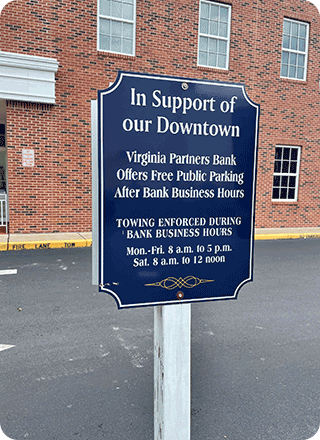
Fostering or encouraging shared-use agreements among property owners can result in increased parking availability for all users.
Parking development
When a true lack of parking capacity (defined as 85% of publicly available spaces filled in a several-block radius) exists, a community may need to explore ways to make additional parking spaces available to meet demand. This often occurs after a significant redevelopment project introduces new users into a district, in popular entertainment districts on summer evenings, or during large events. Some communities will immediately explore opportunities to develop new public parking lots, but this is a costly option for both upfront development and long-term maintenance. Before developing new lots, a community might consider:
- Re-striping or re-signing existing lots to accommodate more spaces
- Implementing variable pricing during peak periods to encourage customers who are able and willing to walk greater distances
- Negotiating with private property owners to make private lots available for public users during off-park hours.
When new spaces are necessary, lots should never front onto major commercial streets, as this will reduce pedestrian activity. When possible, they should be set behind commercial uses (a great opportunity to accommodate much-needed micro retail spaces), or, at the very least, should be shielded from sidewalks by landscaping.
For communities just beginning to explore parking concerns, take pride in the fact that there are enough people interested in visiting your district to create a parking challenge. Then, take the time to assess the current situation by conducting a parking utilization study and a parking survey, which will provide the necessary information for you to make efficient changes that can help your district continue to grow and thrive. For more useful tips, please download our Parking Toolkit, which includes more detailed tips and strategies.
